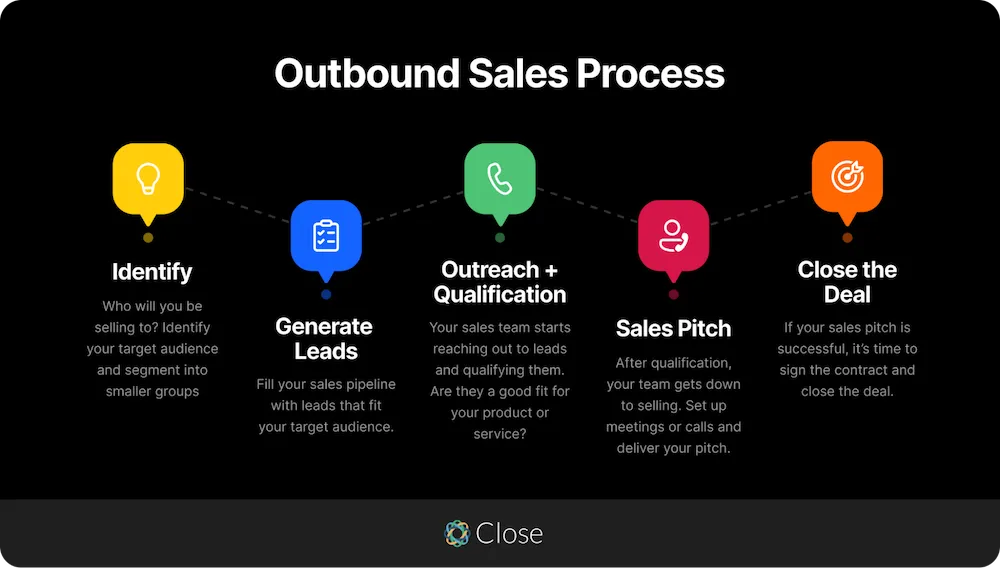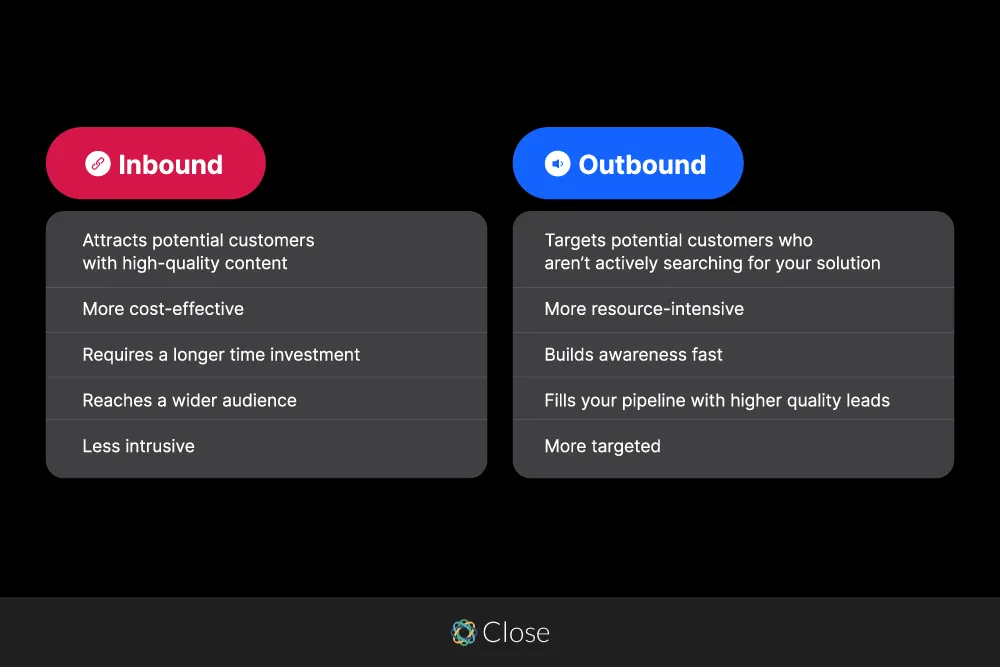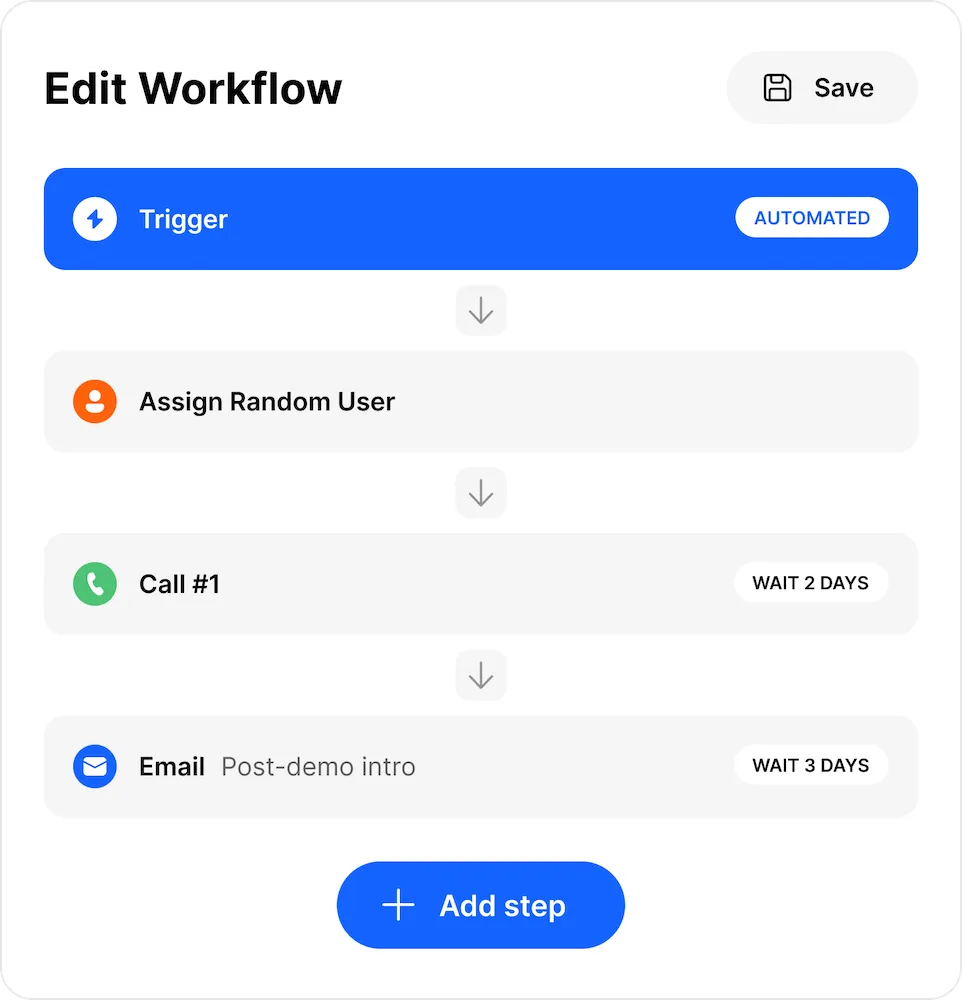
Outbound lead generation is the catalyst that drives the sales cycle, fuels brand awareness, and generates valuable leads.
As we cruise through 2024 faster than Marty McFly cruised through the space-time continuum, we are watching changes that reshape the rules of the game for outbound sales and marketing. To maintain your momentum, staying abreast of the latest trends and tactics is not just beneficial—it's essential.
This article explores the seven best outbound lead gen strategies of today, and shows how your business can use them for faster and more effective growth.
What is Outbound Lead Generation?
Outbound lead generation is a proactive search for customers that fit your ideal customer profile. It involves sales tactics like cold calling, email marketing, and outreach through social media platforms like LinkedIn.
The goal is to engage your target audience, spark interest, and convert prospects into sales-qualified leads. Typically, lead generation is the second step in the outbound sales process. After you identify your target audience, you’ll start working on the sales pipeline.
 |
Here’s the deal—outbound is still a combination of both marketing and sales working together, but it’s a more sales-heavy strategy.
When it comes to outbound lead generation, sales development teams generally take the lead in identifying ideal customers, creating a list of contacts, and making that initial outreach. Prospecting tools such as LinkedIn Navigator or Apollo can be extremely helpful in this process.
Outbound Lead Generation vs. Inbound Lead Generation
Want new leads? A mix of inbound and outbound is the best way to generate a consistent flow of high-quality leads.
Here are the main differences between these two strategies:
 |
Inbound lead generation is generally handled by your marketing team. The goal—get high-quality leads to come to you. Your marketing team goes all-in with creating content, doing PPC ads, posting on social media, and optimizing your online presence to attract potential customers organically.
Outbound lead generation takes a more proactive approach by reaching out to potential customers directly. It involves targeted outreach through cold calling, email campaigns, retargeting campaigns, and even in-person visits (if that’s a thing in your industry).
In basic terms: inbound lead generation creates an attractive digital storefront for your leads to come to, while outbound lead generation is like standing outside the door of that store and telling people to come inside.
Pros and Cons of Outbound Lead Generation
Every strategy has its strengths and weaknesses. Here’s what you can expect when it comes to outbound lead generation:
Pros of outbound lead generation:
- Boost awareness faster: It enables your business to take a proactive stance. You're not waiting for leads to find you; you're actively getting yourself on their radar, starting conversations, and following up.
- Fill your sales funnel with ideal clients: Outbound lead generation tools allow you to hone in on specific demographics, industries, and professional roles. This targeted approach makes it possible for your team to focus their time only on the people who are most likely to become happy customers.
- Shorten your sales cycle: With outbound lead generation, you have the luxury of looking specifically for prospects who are showing clear signs of being purchase-ready. Reach out to people who are ready to buy, and your sales cycle will be much shorter.
While outbound lead generation offers significant benefits, it comes with its own set of challenges. Being aware of these can help you prepare better.
Cons of outbound lead generation:
- The processes can be resource-intensive: The outbound lead generation process involves researching potential clients, creating personalized messages, getting the right contact information, and following up consistently. This can be time-consuming, which is why some companies outsource lead generation.
- Gaining momentum requires mastery: Each aspect of outbound marketing must be tailored to your audience. It's a skill that requires a nuanced understanding of your target market and continuous learning.
- Staying on top of shifting trends is the key to success: Markets evolve, consumer behavior changes, and technology advances. Staying relevant means constantly adapting your outbound lead generation strategy to these changes.
Outbound lead gen might feel like a heavy load to carry single-handedly. That’s why you need a team with diverse skills and the right lead generation tools to navigate these challenges.
7 Effective Outbound Tactics for Lead Generation
While these tactics may seem pretty simple at first, you’ll see that they’re packed with practical examples from sales experts.
You already know you’re supposed to “do LinkedIn outreach” and “personalize your emails.” So we’re not going to tell you that again. Instead, we talked to people who spend their days doing outbound lead gen, and they told us how they’re maximizing gains with these key strategies.
Let’s dive in.
1. Reach Out to Your Ideal Customers (ICP) to Avoid Yawns at Your Pitch
If you’re doing cold outreach randomly, there is a high chance that the prospect won’t be interested. Let’s be honest—most people don’t want to be interrupted at work, especially if it doesn’t give them instant value.
There is no single remedy that can fix it. But you can increase your chances of success by talking to people who are already interested. Start with designing ideal customer profiles and buyer personas to know who to pitch to. We’ll focus on the ICP, a company your buyer persona works for.
Your Ideal Customer Profile (ICP) should include:
- Specific characteristics of companies you should sell to, such as the type of company and business model
- Common behaviors of people working in those companies
- Relevant use cases that demonstrate how your product or service can be beneficial to them
- The buying cycle, which helps you understand when and how to engage with potential customers
By developing these profiles, you will be able to identify leads that have a higher potential for conversion. Your outreach database will be filled with companies that align with your target market. You can enhance your database by incorporating insights from market research, mining data, or segmenting it into customer groups.
Remember, your ICP should not solely focus on demographics. Companies from different parts of the world can share similar traits, behaviors, and use cases. Therefore, when creating your ICP, consider psychographics and firmographics as well.
2. Check if Your Product Can Solve Their Pain Points
Outbound lead generation often involves contacting prospects through cold calls or emails. But if you’re seeing metrics like high open rates but no new bookings, it may be that you’re not tapping into prospects’ pain points.
Thus, developing a deep understanding of your target customer's pain points is key.
Take a look at those four basic questions to ask to learn more about their challenges:
- What are you struggling with?
- What’s the main challenge you’re facing right now?
- What’s the issue with your current process?
- What’s the outcome you’d expect after making a change?
Listen carefully to the answers— they will give you a wealth of knowledge about the struggle and desired outcomes.
They should help you in two important ways. First, it will be easier for you to position your product as a solution to these pain points. Second, the customer's voice should guide your messaging.
Incorporate exact phrases that your customers use, so your outreach sounds persuasive and authentic to your prospects.
3. Use the Voice of the Customer to Craft Messaging that Resonates
Have you ever got messages like "Following up,” “Did you see my last message?,” or “Are you still interested?” Well, we bet you have.
The issue with such messages is that your recipient doesn’t care what the initial message was about. Thus, every email to your leads should contain a core message that resonates with this particular audience.
Another thing is that it’s not ChatGPT or your boss that should give you tips on your outbound messaging. It’s actually your customers and their voices that should be the foundation of messaging that works.
A great example comes from Florin Tatulea, Director of Sales at Barley. See how he crafts messaging that gets traction.
This type of email got him hundreds of meetings because it clicked with his target audience—it used their language and made it clear he understood their pain points (and could solve them).
4. Know When to Employ Sales Intelligence Tools To Find Primed Leads
Sales Intelligence tools will help you build a solid database of new leads who are more likely to convert into your customers. Tools like LinkedIn Sales Navigator, Zoominfo, or Clearbit will be helpful here.
Here’s how it works:
- Once inside your lead generation tool, start by defining your Ideal Customer Profile with characteristics like industry, company size, job titles, location, and other relevant criteria.
- Build your list of leads. Most sales intelligence tools give you search filters—use them to narrow down your search and identify leads that match your ICP.
- Take the resulting list and export it into your CRM.
- Start reaching out!
5. Try Various Communication Channels Before You Give Up on That Lead
We’ve all been in a situation where you sent out three cold emails without a response. Is it time to move on?
Absolutely not!
Instead, try reaching out to audiences through multiple channels. It’s better because it supports your business presence across the non-linear path of informed buyers. By trying out various channels, you see how individuals prefer to be contacted. Be the seller that shows up, and you’ll be the seller who gets the sale.
Take a look at three key practices when doing multichannel outreach:
- Know which channels your audience is using. For example, if you’re targeting professionals, try LinkedIn. If you’re targeting Gen Z consumers, try TikTok.
- Look for where audience preferences and your team’s skills align. If you suck at LinkedIn, don’t throw 100 percent of your efforts there. Play to your strengths.
- Use automation when you can, but don’t lose the human factor of your outreach.
By following these principles, you can enhance audience engagement, guide campaign refinement, and ultimately boost the success of your outreach efforts.
6. Use Video to Stand Out and Personalize Your Messaging
Video is still a hot topic in outbound sales. And the greatest thing—there are still very few sales reps using this effectively.
This works because it helps you:
- Stand out in the crowded inbox
- Become top-of-mind as you’re doing something differently
- Stay more human in the sea of robotic, AI-gen outreach
There are many ways you can include videos in your outreach. Here’s a very solid example from Hilary P Johnson, Business Growth Consultant at Hatch Tribe, who mastered using videos in outreach.
“We regularly use Loom to record personalized videos for people in our pipeline. Typically, we send the video as a follow-up to our initial consultation. They've already talked with us, seen our pricing, and know the full details of what's included.
To keep it super engaging and personalized, we record a Loom with a background of their website. It's usually a short message to check in and ask, ‘How are you feeling about working together?’ I make it a point to let them know I'm happy to answer any other questions that may have popped up since we last talked.
The engagement from these emails and videos is high. Our clients have noted that these messages felt personalized and like we actually cared about them, which we do! And it's a great way to build rapport with clients before we begin working together.”
She notes that it’s been an important part of their sales process. Thus, they apply this practice with every single lead.
Learn how to do video outreach at scale:
7. Build Automated Outreach and Sequences for Better Lead Gen
Automation is awesome—as long as you don’t lose the human factor. The best part of automating your sequence is that you can save time while still keeping the same level of personalization.
Of course, you need to make sure you’re using the right tools to do that.
With Workflows in Close, you can automate sending follow-up emails, doing phone calls, sending SMS, and other tasks. Use variables to insert the person’s name, company, and other relevant details without skipping a beat.
Best of all, you can automatically assign new leads to your sales reps as they enter your CRM.
 |
Here’s one messaging approach you can try (from Scott Barker and the GTM Newsletter):
 |
The idea is to prepare three different value propositions and bucket them in sequences. Say the first one is “Efficient project planning and scheduling,” and it hasn’t worked well. So, you continue to test another sequence with a new value prop. This way, you’ll check what works and what doesn’t.
Get the most out of your workflows in Close by checking the metrics: You’ll see average response ratio, the average response time, bounce rates, and more. This tells you the health of your sequences, and gives you ideas on how to improve them.
 |
Final Thoughts: 3 Outbound Lead Generation Trends You Need to Know
The world of outbound lead generation is transforming at a breakneck pace. Staying ahead of the curve requires a firm grasp of these game-changing tactics and watching out for the trends. Here are three trends to have on your radar in 2024:
1. Account-Based Marketing is No Longer Optional
ABM serves as a way for marketing and sales teams to focus their energy and resources on distinct companies and their decision-makers so they can gain traction faster.
The buyer's journey is no longer a linear path—it is an intricate maze with well-informed and engaged buyers. ABM rises to this challenge, reaching potential customers at every step of their journey with custom follow-up content, boosting conversion opportunities.
The key to excelling with ABM is fostering collaboration between sales and marketing teams. Don't let information silos hamper your efforts—work towards a unified, customer-centric approach.
2. Social Selling is a Sales Rep’s Best Friend
LinkedIn, being the most extensive professional networking hub with over 830 million members, offers an expansive audience reach, which makes it an ideal platform for social selling.
Its power is not just in its volume but also in its precision. You can use LinkedIn's advanced targeting capabilities to zero in on specific industries, job titles, and companies, ensuring their social selling messages reach the intended audience.
Focus on broadening your network to tap into potential leads, regularly share high-quality content, and engage in your professional community. Don't forget to use LinkedIn's features like InMail and Sales Navigator for a strategic advantage.
3. Using a CRM Should Help You Maximize Your Outbound Lead Generation Process
Your CRM will serve you as a central hub for managing all the outbound activities. It can help you improve outreach efforts, automate follow-ups, and keep track of all the information about your leads.
Why is it worth it? Here’s one reason: using an automated dialer, you can increase your outbound call volume by 300 percent. Plus, a communication-focused CRM (like Close) will also allow you to schedule emails and SMS messages, drop pre-recorded voicemails, and quickly run through your list of leads to contact as many people as possible.
Ready to embrace the changes and get ahead of the trends? Use the CRM for high-powered outbound sales teams—try Close for 14 days, at no cost (we won’t even ask for your credit card).










